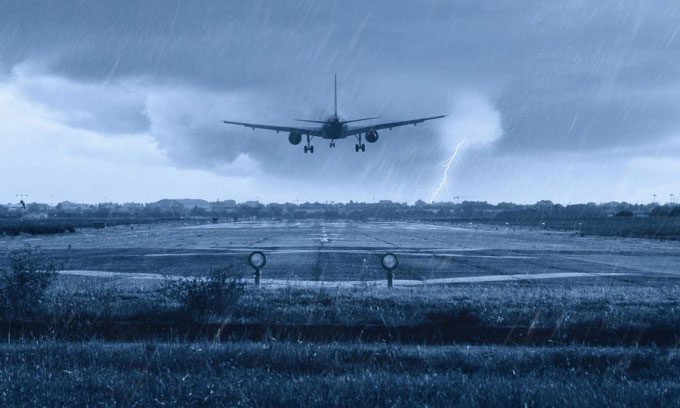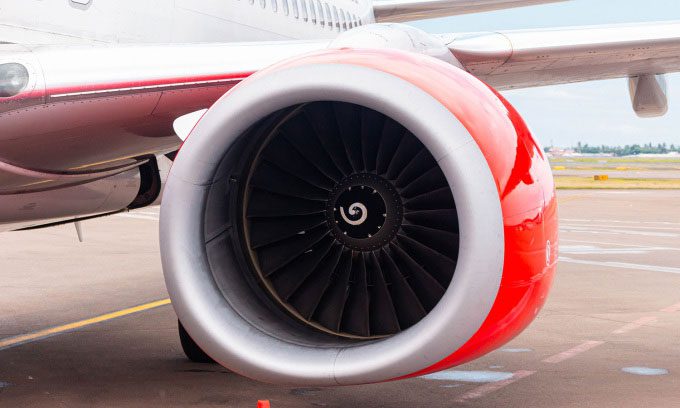Normal rain is unlikely to disrupt the combustion process of aircraft engines, but freezing rain, snow, and hail pose greater risks.
Winter weather, including rain, snow, and freezing rain (which occurs when rain freezes upon contact with the ground or a solid object), can affect aviation operations. However, modern technology has made aircraft more resilient, allowing them to operate even under less-than-ideal conditions.

Severe weather can impact aviation operations. (Photo: 123Rf).
Current turbofan engines operate by burning fuel internally. The low-pressure (LP) and high-pressure (HP) compressor blades draw air into the engine towards the combustion chamber. Here, the air mixes with fuel and is expelled as exhaust to propel the aircraft forward. A significant portion of the air circulates through the core of the engine and moves between the engine casing and the combustion core. It remains compressed as it exits, generating over half of the engine’s overall thrust while also cooling the central core.
Commercial jets often fly through thunderstorms. During these conditions, the engines rapidly ingest large amounts of water while maintaining a safe thrust level. Not all of the water passes through the engine’s core. The compressor blades initially capture the water flow, spinning and directing it outward to the engine’s casing through centrifugal force. This allows the water to bypass the airflow system, preventing contact with the combustion chamber within the engine core.
Normal rain is unlikely to disrupt the combustion process, even in jet engines without bypass systems. The extremely high temperatures in the engine’s combustion chamber, sometimes reaching 900 degrees Celsius, convert the incoming water into steam without significantly affecting the engine’s output.
Freezing rain and snow present more challenges as they can cause ice to accumulate at the engine’s intake. In such cases, the ice can break off and collide with the blades, damaging them and potentially causing compressor stalls. To combat this, the intake is heated to prevent ice formation.
Hail can also be a concern when aircraft approach severe thunderstorms. Not only can it affect the engines, but hail can also damage the aircraft’s exterior. Pilots are often advised to stay at least 32 kilometers away from thunderstorms. In 2021, an Emirates Boeing 777-300ER encountered severe hail while taking off from Milan Malpensa Airport. The aircraft had to turn back after sustaining significant damage and a shattered windshield.

During production, aircraft engines are rigorously tested to withstand thunderstorms. (Photo: Simple Flying).
According to the National Weather Service (NWS) in the United States, during freezing rain, freezing fog, or heavy snow, crews can remove ice buildup by running the engines in multiple intermittent bursts. If power is lost due to ice or a large influx of water in the combustion chamber, pilots can attempt to restart the engine or safely utilize the automatic ignition system, according to Aerospace Web.
Jet engines undergo thorough testing to withstand thunderstorms. One of the steps in certifying an aircraft is to fly it in adverse weather conditions. Preparation for this occurs on the ground. Engine manufacturers like General Electric and Pratt & Whitney have advanced testing facilities to ensure that engines can withstand heavy rain.
Engines are tested under various conditions, including the introduction of foreign objects to simulate bird strikes. In the case of the GEnx engine produced by General Electric, massive nozzles spray three tons of water per minute into the engine to test for weaknesses, followed by one ton of artificial hail.
Today, advancements in onboard weather radar technology can help crews avoid areas of severe weather. Such systems can detect concentrations of particles like hail, rain, and ice crystals such as snowflakes. Overall, engine shutdowns due to snow are still less common than running out of fuel.



















































